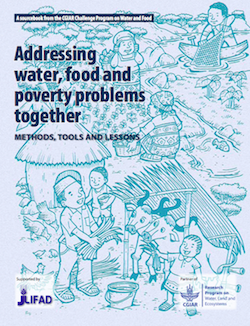Conservation agriculture: a climate-smart way to improve water management

During a time when climate change is causing extreme weather variability—including inter- and intraseasonal droughts, flooding, and high uncertainty about the onset of rainy seasons—better management of water for food production is called for.
A new sourcebook from the CGIAR Challenge Program on Water and Food (CPWF), entitled Addressing Water, Food and Poverty Problems Together—Methods, Tools and Lessons, highlights conservation agriculture as an effective way to improve water productivity, crop yields, and farmers’ incomes. The book draws on CPWF’s first phase of research (2004-2008) and its instructive articles outline some of the methods for increasing ecological and social resilience that CPWF have found particularly promising.
The book draws on CPWF’s first phase of research (2004-2008) and its instructive articles outline some of the methods for increasing ecological and social resilience that CPWF have found particularly promising.
The book defines conservation agriculture as:
“[T]he application of modern agricultural technologies that collect and store rainwater to improve production, while at the same time, protecting and enhancing the land resources on which production depends.”
Piloting conservation agriculture in the Andean and Limpopo River Basins
In the Limpopo River basin, where up to 50 percent of water flow is unproductive, CPWF piloted conservation agriculture in partnership with local farmers.
One of the corner stones of conservation agriculture is zero tillage. Instead, farmers combined relatively simply and well-known agricultural technologies—such as planting basins and tied ridges—with minimal fertilization and supplemental irrigation. As a result, farmers improved their access to green water, and, using it for additional irrigation, achieved increased crop yields.

Read the full article: Farmer-centered conservation agriculture research (pdf)
Similarly, in the Andean river basins, where steep slopes and hillsides require effective crop and soil management, CPWF piloted a conservation agriculture system to maintain productivity, even with climate change making rainfall erratic and unpredictable.
The Quesungual Slash-and-mulch Agroforestry System was originally developed by the Food and Agriculture Organization (FAO), national institutions in Honduras, and local farmers. CPWF scaled out the production system in watersheds of Honduras, Nicaragua, and Guatemala. The main recommendations of the production system are to abandon slash-and-burn practices, to use biomass from trees as permanent soil cover, to avoid tillage of the soil, and to efficiently use fertilizer.
CPWF found the Quesungual Slash-and-mulch Agroforestry System to be an effective model for implementing conservation agriculture. Smallholder farmers were able to achieve larger crop yields while maintaining ecosystem services, despite land degradation and climate change.
Read the full article: Conservation Agriculture as an Alternative to Slash-and-Burn Systems (pdf)
Lessons on Conservation Agriculture
CPWF has observed improved water management and substantial increases in crop yields as a result of conservation agriculture—a methodology that further holds the promise of being easily adoptable by resource-poor farmers. However, some limitations must be noted: Local conditions to a large part determine the effectiveness of conservation agriculture, and significant year-to-year variations in crop yields may occur.
In addition to conservation agriculture, the book, Addressing Water, Food and Poverty Problems Together—Methods, Tools and Lessons, presents more than 50 articles on methods, approaches, and lessons on improving water management for food production. All book chapters are available for download via CPWF website.
About CPWF’s New Learning Portal
From 2002 to 2013, the CGIAR Challenge Program on Water and Food piloted new ways to better manage water for food production and nature conservation. The program supported more than 120 research projects in ten of the world’s largest river basins. A new web-based learning portal presents the program’s findings on the water, food, and poverty challenges faced by the world today. It also provides insights into lessons learned on CPWF’s research-for-development (R4D) approach. Learn more via Water and Food Source site.
Marianne Gadeberg is a freelance writer, editor, and communications specialist.
